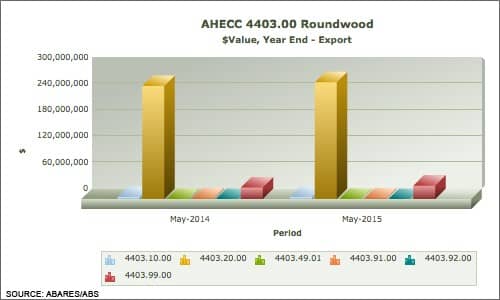Imports of sawn softwood totalled 713,891 m3 in the year-ended November 2015, a rise of 16.9% compared with the prior year. The total annual import volume was 3.1% below the peak reached in July 2015, driven down by lower monthly imports in recent months that have apparently been impacted by the depreciating Australian Dollar.
The chart below shows the recent experience of sawn softwood imports, with a monthly record of 70,513 m3 achieved in April 2015. By way of contrast, imports had fallen 25.5% to 52,539 m3 in November 2015.

To go straight to the dashboard and take a closer look at the data, click here.
As the longer experience shows, monthly import volumes have not typically displayed strong seasonal characteristics. It seems that experience continued over the last year, with solid import growth through to April 2015, before a depreciating Australian Dollar, among other factors, placed pressure on sawn softwood imports.
Further analysis shows that a reasonably large proportion of the rising imports was delivered by a sharp rise in dressed sawn softwood imports. Imports spiked sharply in the first four months of 2015, as the chart below shows. Record monthly imports of 29,718 m3 were recorded in February 2015. The result is that for the year-ended November 2015, total imports were 266,758 m3, up 66.6% on the prior year.

To go straight to the dashboard and take a closer look at the data, click here.
It is important to examine the cause of the (largely) short-lived import spike. As the detail below shows, supplies from Estonia and Sweden have risen most steeply, with all of the listed European suppliers showing increases for the year-ended November 2015.
Country of Origin Year Ending November
| Country | YE Nov ‘14 | YE Nov ‘15 | YoY % Change |
| Austria | 42,769 | 43,863 | 2.6 |
| Estonia | 38,848 | 66,969 | 72.4 |
| Finland | 24,533 | 36,631 | 49.3 |
| Germany | 949 | 6,987 | 636.2 |
| Lithuania | 27,161 | 32,154 | 18.4 |
| Sweden | 14,019 | 71,089 | 407.1 |
| USA | 6,159 | 1,162 | -81.1 |
| Other | 5,664 | 7,723 | 36.4 |
The fall in the always small imports from the USA appears to be related to the relative exchange rates for the Euro and the US Dollar. The Australian Dollar’s depreciation against the US Dollar has been far more pronounced than against the Euro, providing the Eurozone importers with a competitive advantage over the American counterparts.
Currency however does not explain the large spike in imports from Estonia and Sweden in the early part of 2015. That has as much to do with the importer’s corporate strategies and supply-side dynamics in stagnating Europe as it does with Australia’s clearly strong demand.



